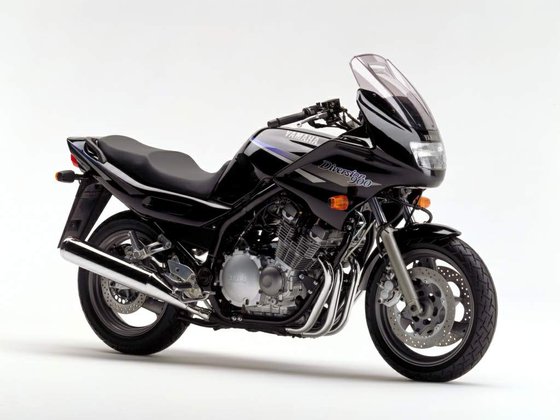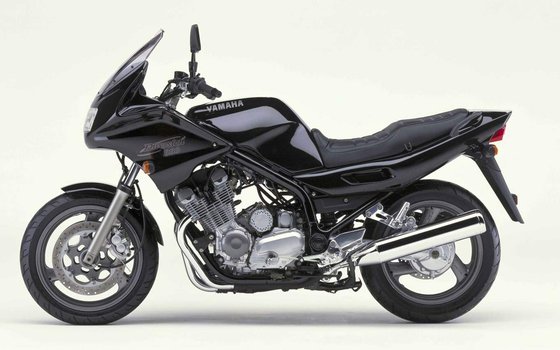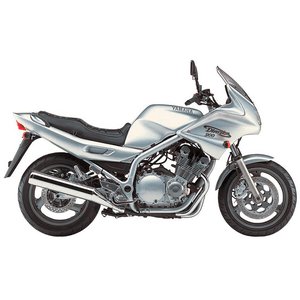Yamaha XJ 900 F Diversion (1994–2003): The Understated All-Rounder That Still Delivers

Introduction
The Yamaha XJ 900 F Diversion is a motorcycle that defies flashy labels. Produced from 1994 to 2003, this air-cooled inline-four has carved out a reputation as a steadfast companion for riders who value practicality over pizzazz. Designed as a jack-of-all-trades, it’s a bike that commutes, tours, and even dabbles in light sport riding without ever breaking a sweat. But does it still hold up today? After a day spent hustling a well-preserved 2001 model through mountain roads and highway stretches, the answer is a resounding yes—with a few caveats. Let’s dive into what makes the XJ 900 F a cult classic for riders in the know.
Engine Performance: Reliable, If Not Revolutionary
At the heart of the XJ 900 F lies a 892cc air-cooled inline-four engine, a design that traces its roots back to the mid-1980s. With 89–92 HP (65–67 kW) at 8,250 RPM and torque peaking at 77–84 Nm (57–62 lb-ft) around 7,000 RPM, this powerplant prioritizes smoothness over raw aggression.
On the Road:
- The engine’s personality is decidedly old-school. Throttle response from the Mikuni CV carburetors is linear, with a meaty midrange that makes overtaking effortless. Above 6,000 RPM, vibrations creep into the bars and pegs, a gentle reminder that this isn’t a high-strung sportbike.
- Shaft drive eliminates chain maintenance hassles and delivers buttery-smooth power delivery. However, it adds weight—a trade-off evident when pushing hard into corners.
- Fuel efficiency averages 17.6 km/l (41.4 mpg), giving a range of 400+ km (250+ miles) from its 24L (6.3-gallon) tank—a boon for tourers.
The Catch:
The XJ 900 F won’t set your hair on fire. Its 0–100 km/h (0–62 mph) time of ~4.3 seconds and top speed of 209 km/h (130 mph) feel adequate rather than thrilling. But for riders seeking stress-free longevity, the engine’s simplicity is a virtue. Valve adjustments (intake: 0.11–0.15 mm / exhaust: 0.16–0.20 mm) are straightforward, and the air-cooled design sidesteps radiator leaks.
Handling and Suspension: Comfort Over Corners
Weighing in at 239 kg (527 lbs) dry, the XJ 900 F isn’t a lightweight. Yet, its low center of gravity and neutral steering geometry make it surprisingly manageable at low speeds.
Chassis Dynamics:
- The 41mm telescopic forks and Monocross rear shock are tuned for plushness. On smooth asphalt, the ride is sublime. But hit a bump mid-corner, and the suspension struggles to recover quickly—a trait highlighted during aggressive riding in the Alps.
- Braking performance is solid for its era. Dual 320mm front discs with 2-piston calipers provide ample stopping power, though modern riders might crave more initial bite.
Tire Notes:
The stock Dunlop K505 tires prioritize mileage over grip. Upgrading to stickier rubber (like Michelin Road 6 or Bridgestone Battlax) transforms cornering confidence, especially in wet conditions.
Comfort and Ergonomics: Built for the Long Haul
Yamaha nailed the touring credentials here:
- The 795mm (31.3") seat is wide and supportive, accommodating taller riders without a cramp-inducing reach to the bars.
- The half-fairing and tall screen deflect wind effectively, though buffeting at highway speeds can be mitigated with an aftermarket windscreen.
- Passenger accommodations are generous, making two-up touring a viable (if leisurely) endeavor.
Quirks:
The analog gauge cluster—complete with a fuel gauge and gear indicator—feels charmingly retro. However, the switchgear’s “euro” layout (including a headlight kill switch) might confuse riders accustomed to U.S.-spec bikes.
Design and Styling: Subtle to a Fault
The XJ 900 F’s styling is unapologetically utilitarian. Its slab-sided fairing and understated color schemes (blue, red, green, or silver) scream “sensible shoes.” Yet, there’s a timeless quality to its no-nonsense design. The shaft drive and twin exhausts add a touch of mechanical honesty, while the 17" wheels keep proportions balanced.
Aesthetic Upgrades:
- Swapping the stock mirrors for low-profile units sharpens the look.
- A café-style tail tidy modernizes the rear end but sacrifices practicality.
Competition: How Does It Stack Up?
In the 1990s–early 2000s, the XJ 900 F faced fierce rivals. Here’s how it measures up:
- Suzuki Bandit 1200:
- Pros: 25+ more HP, addictive torque.
- Cons: Chain drive requires maintenance, harsh suspension.
-
Verdict: The Bandit is rowdier, but the XJ’s shaft drive and comfort win for touring.
-
Honda CB1000:
- Pros: Silky-smooth engine, premium build quality.
- Cons: Higher price tag, less character.
-
Verdict: The Honda feels more refined, but the Yamaha is cheaper to maintain.
-
Kawasaki GPz 1100:
- Pros: Sportier demeanor, sharper handling.
- Cons: Aging design, cramped ergonomics.
- Verdict: The GPz appeals to thrill-seekers; the XJ to pragmatists.
Today’s Perspective:
Against modern nakeds like the Yamaha MT-09, the XJ 900 F feels antiquated. Yet, its reliability and low running costs make it a smart choice for budget-conscious riders.
Maintenance: Keeping the Legend Alive
The XJ 900 F’s mechanical simplicity is a DIYer’s dream. Key considerations:
- Engine Care:
- Use SAE 20W-40 or 10W-40 oil (2.8L with filter).
-
Check valve clearances every 10,000 km (6,200 miles).
-
Shaft Drive:
-
Replace final drive oil (SAE 80 GL-4) every 20,000 km (12,400 miles).
-
Brakes:
-
Flush brake fluid (DOT 4) annually. Pads from the FJ1200 are a direct fit for improved bite.
-
Suspension Upgrades:
-
Progressive springs for the forks ($120–$150) and a YSS shock ($300–$400) transform handling.
-
Electrics:
- The TCI ignition is robust, but keep spare NGK BPR8ES plugs (gap: 0.7–0.9 mm) on hand.
MOTOPARTS.store Recommendations:
- Upgrade to EBC HH sintered brake pads.
- Install a DNA air filter for smoother throttle response.
- Swap to Pirelli Angel GT tires for all-weather grip.
Final Thoughts
The Yamaha XJ 900 F Diversion isn’t about headlines—it’s about miles. It’s the bike you ride to work, take on a weekend tour, and still trust to start on the first click of the starter. While its performance won’t dazzle, its dependability and low-key charm have cemented its status as a modern classic. For riders who value substance over spectacle, the XJ 900 F remains a compelling choice—and with a few thoughtful upgrades, it can still hold its own against newer machines.

The Yamaha XJ 900 F Diversion: Proof that sometimes, the quiet ones are the ones worth listening to.






Specifications sheet
| Engine | |
|---|---|
| Stroke: | Four-stroke |
| Max power: | 67 kW | 90.0 hp |
| Max torque: | 84 Nm |
| Fuel system: | 4x 31mm Mikuni CV carburetors |
| Max power @: | 8250 rpm |
| Displacement: | 892 ccm |
| Max torque @: | 7000 rpm |
| Configuration: | Inline |
| Cooling system: | Air-cooled |
| Compression ratio: | 10.0:1 |
| Number of cylinders: | 4 |
| Valves per cylinder: | 2 |
| Dimensions | |
|---|---|
| Wheelbase: | 1505 mm (59.3 in) |
| Dry weight: | 239 |
| Seat height: | 795 mm (31.3 in) |
| Overall width: | 750 mm (29.5 in) |
| Overall height: | 1300 mm (51.2 in) |
| Overall length: | 2230 mm (87.8 in) |
| Ground clearance: | 130 mm (5.1 in) |
| Fuel tank capacity: | 24 L (6.3 US gal) |
| Drivetrain | |
|---|---|
| Final drive: | shaft |
| Gear ratios: | 1st: 2.19:1, 2nd: 1.50:1, 3rd: 1.15:1, 4th: 0.93:1, 5th: 0.81:1 |
| Transmission: | 5-speed, wet multi-plate clutch |
| Maintenance | |
|---|---|
| Engine oil: | 10W40 |
| Idle speed: | 1050 ± 100 rpm |
| Brake fluid: | DOT 4 |
| Spark plugs: | NGK DPR8EA-9 or NGK DPR8EIX-9 |
| Spark plug gap: | 0.9 |
| Final drive oil: | 200 ml SAE 80 GL-4 |
| Forks oil capacity: | 0.882 |
| Engine oil capacity: | 3.4 |
| Engine oil change interval: | Every 5000km or 2 years |
| Valve clearance (intake, cold): | 0.11–0.15 mm |
| Valve clearance check interval: | 24,000 km |
| Valve clearance (exhaust, cold): | 0.16–0.20 mm |
| Recommended tire pressure (rear): | 2.9 bar (42 psi) |
| Recommended tire pressure (front): | 2.5 bar (36 psi) |
| Performance | |
|---|---|
| Top speed: | 209.9 km/h (130.4 mph) |
| Fuel consumption (average): | 17.6 km/L (41.4 mpg) |
| Chassis and Suspension | |
|---|---|
| Frame: | Steel double cradle |
| Rear tire: | 150/70-17 |
| Front tire: | 120/70-17 |
| Rear brakes: | Single 245mm disc, 2-piston caliper |
| Front brakes: | Dual 320mm discs, 2-piston calipers |
| Rear suspension: | Swingarm monocross |
| Front suspension: | 41mm telescopic forks |
| Rear wheel travel: | 100 mm (3.9 in) |
| Front wheel travel: | 140 mm (5.5 in) |



















